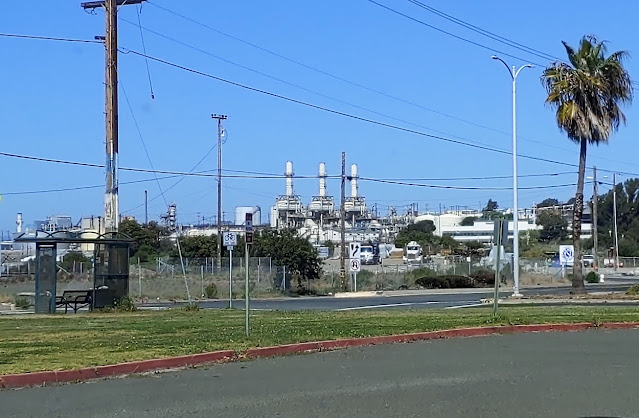
A bus stop across the street from the Phillips 66 refinery in Rodeo, CA. Less than a mile away are homes, a school, medical center, and sanitation department. Photo: Zsea Bowmani
Frontline communities too often experience one environmental injustice after another—water pollution from heavy industries, contamination from shuttered factories, and a lack of access to fresh food in the case of South Vallejo, a predominantly Black low income community in Northern California. Yet, legal solutions tend to address these issues in isolation. The intractable nature of these cumulative burdens are what gave Zsea Bowmani, SCU environmental law professor and head of the Environmental Justice Law and Advocacy Lab, the idea to examine one of California’s civil rights laws as a tool in the fight against environmental discrimination.
CA Government Code §11135 is the state’s analog to Title VI of the federal 1964 Civil Rights Act, which prohibits discrimination in government-funded programs and activities. Unlike Title VI, §11135 bans not only intentional discrimination but actions that appear to be neutral but have a negative, disparate impact on a protected group or person. Initially enacted by the California legislature in 1977 with supporting regulations passed three years later, §11135 was intended to apply broadly and has since expanded to cover discrimination based on sex, race, color, religion, ancestry, national origin, ethnic group identification, age, mental disability, physical disability, medical condition, genetic information, marital status, or sexual orientation.
Over the years, advocates have used §11135 to provide meaningful voting access for disabled people, challenge racially stratified school disciplinary actions, and secure housing benefits for LGBTQ veterans, among other things. §11135’s use in environmental contexts has seen varying levels of success. For example, in 2016, our community partner Greenaction for Health & Environmental Justice filed a §11135 complaint against the California EPA and state Department of Toxic Substances Control in response to racial discrimination in their decision to expand the Chem Waste Kettleman Hills hazardous waste landfill, eventually securing a historic and precedent-setting settlement, although the final settlement was based on Title VI. A year earlier, however, a coalition of youth groups and community organizations tried but were ultimately unable to use §11135 to hold Los Angeles city officials responsible for racially discriminatory approvals of oil wells near Black and Latinx neighborhoods.
Despite such setbacks, we at the EJ Law and Advocacy Lab believe §11135 has the potential to bring relief to communities across the state facing cumulative environmental burdens. Professor Bowmani is working with second-year SCU law student Max Jones and community partner All Positives Possible to learn what makes a §11135 complaint successful and how to address legal pitfalls like those seen in the Los Angeles case. Our goal is to create a resource guide that All Positives Possible can use in their South Vallejo advocacy, as well as other community groups throughout California.